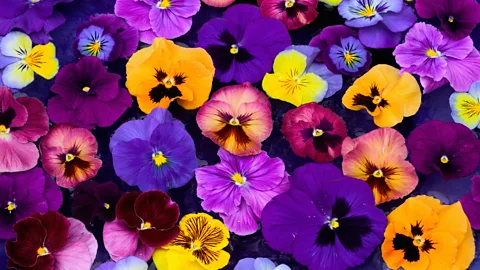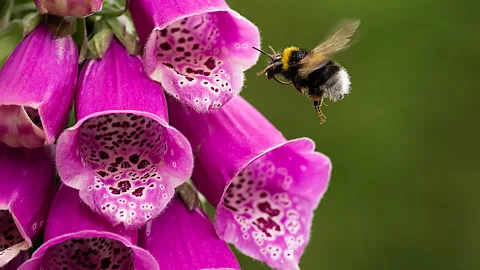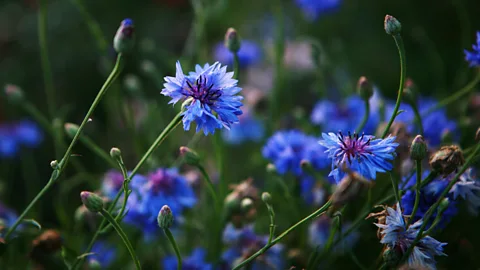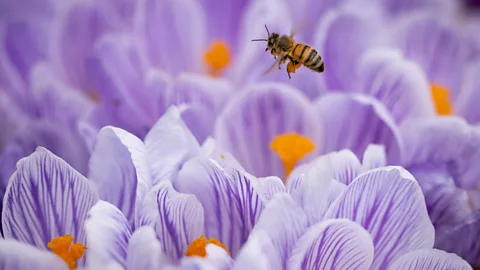The beautiful flowers that bees can't use
 Getty Images
Getty ImagesWe're often tempted to add flowers to our gardens to attract bees and promote biodiversity. But what if this is sometimes a bad idea?
To decorate green spaces, most cities and amateur gardeners rely on horticultural plants – those that have been selectively bred for certain qualities, such as their ornamental value. With their flashy colours, unusual shapes and larger proportions, they may be attractive to the human eye. But they are not necessarily useful for bees and other pollinators.
Often, it may be the contrary: one popular garden flower native to South America, the petunia, originally had five petals. Because of artificial selection, hybrid varieties now sometimes have 10.
"We love big, puffy, and flashy flowers. To make flowers more attractive, we selected some double-petal species. It gives the impression that the flower is bigger. But, in reality, the nectar part, which is vital for pollinators, might not exist anymore because of this selection. In other cases, it may be hidden by the petals," explains Stephanie Frischie, native plant materials specialist at Xerces Society, a non-profit organisation based in Portland, Oregon.
This is exactly what happened to the petunia. In the hybrid "double-flowered" varieties, the parts that produce nectar have largely disappeared, as the plants gradually invested more in their large, numerous petals. Meanwhile, one early study found that some horticultural varieties of pansies often either contain almost no nectar or are inaccessible to bees due to the shape of their flowers.
Now our cities are full of these plants selected for their aesthetic properties. "A few years ago, you would be able to see wild plants in our cities but, progressively, things changed. City owners began to choose ones that are appealing to humans. These criteria are less obvious for insects, who are suffering from this selection," says Frischie.
In Germany, 70% of plant species are in decline across the country. Species richness at the landscape scale has decreased by an average of 1.9% per decade over the past 60 years. Invasive species are thought to be contributing to this decline, many of which are being introduced via our gardens.
The decline of bees is not only due to selective breeding. It is also caused by the importation of "exotic" species from abroad. Non-native plants can seem more appealing to humans – perhaps because of their vibrant colours, unusual flower shapes or cultural heritage – that doesn't mean insects see them in the same way.
 Getty Images
Getty Images"In the past, most Australian cities would look like British cities, so they planted British species trees in their towns," says Katherine Berthon, an urban ecologist and postdoctorate at RMIT University of Melbourne. "But British trees are different: most of them lose their leaves in winter. Instead, Australian ones do not. Pollinators do not recognise something to eat on these non-native trees. Insects are very picky about what food they choose and it is foreign to them," she says.
We think that bees can match all flowers, but it is not the case: most of them need to find the right match between the chemical properties of the plant and their own physiology when they pollinate. "Bees are not generalists, they are much more narrow-minded," says Frischie.
Magali Deschamp is an urban ecologist at Marseille University, France. She worked on the creation of an urban park in the centre of the city intended to attract native and Mediterranean butterflies. When she started her research 10 years ago, only four species of Mediterranean butterflies survived in the center of Marseille. Pacha's caterpillar, a Mediterranean butterfly species, had disappeared from the city. "Pacha's caterpillar only uses sea buckthorn as a host plant. Without it, no butterfly will stay in a garden for reproduction. We planted new native sea buckthorn species to attract them. It took six years for the butterflies to come and take ownership of the place," says Deschamp.
After 10 years of research and gardening, the garden's butterfly species have doubled. "If you are just putting in horticultural plants, it may help city owners to fight against heat waves in summer. But it will not be necessarily useful for insects," says Deschamp.
And insects are not the only problem. Plants are also sensitive to new environments. Sometimes a non-native plant looks like a native one but does not open in the right season in order to be pollinated and reproduce successfully. A native European flower might open in spring, but an American may not open at the same time, even if it belongs to the same species. Like insects, plants need time to adapt to an environment. This can sometimes take decades.
Planting more native species would guarantee that bees can find food in our gardens, even if some rare exotic species may also occasionally be beneficial.
 Getty Images
Getty ImagesBut today, only a small minority of the plants sold by commercial nurseries are wild-type native species. For example, one 2017 survey of 14 garden centres in the mid-Atlantic region of the US found that just 5.75% of the plants they sold were this kind. The vast majority are horticultural ones, such as those selectively bred for food or ornamental purposes. You need several months for a native plant to grow, which can discourage owners planting them. Donald MacIntyre, for instance, owns a nursery that grows native plants based in the English city of Bath. "A lot of gardeners give up after a few years because it is really hard. Knowledge and control of the production are difficult," he says.
MacIntyre started his production of native plants in 1980 after studying for a diploma in plant genetics. "At this time, the decline of native plants was not so great, but the decline of the environment and biodiversity was already here," he says. He only collects seeds from wild spaces like nature reserves, which have not been exploited by human activity for decades. Samples are collected using a strict protocol – only limited collection of these wild plant populations is allowed.
When MacIntyre started his activity the demand was not there. "Now needs are growing gradually," he says. MacIntyre's clients are mostly farmers, infrastructure managers, conservatories and nature reserves. Very few private gardeners are buying his products. "There are not many of us. I know of four other nursery owners like me in the UK," he says.
In some countries, producers of local and native plants have joined together in professional networks. German producers created a label with Regiosaaten (a German assurance of quality and origin) about 20 years ago, guaranteeing the traceability of wild and local plants. In France, the Végétal local label is a similar approach. The label has 75 members throughout France. In 2022, the brand received 25 new applications from farms, the first time since its creation in 2018. More recently, a European association, Native Seed, has joined these national networks. Its aims are to promote the "adoption of international standards for native seed in ecological restoration" and the "adaptation to the European native seed supply chain".
But to increase the availability of suitable plants for pollinators, it's not just the plant nurseries that need to change – mentalities must, too.
 Getty Images
Getty Images"Landscape makers may be aware that each plant has its own use", says Frischie. She explains that we must accept that beauty is not necessary all about geometrical shapes. "Some plants can be tall, some lower. You do not have to design something very formal," she says. Garden waste may also be useful to insects: for example, autumn leaves may provide shelter in the winter or summer, so leaving them on the floor is not a bad idea. "Insects use them to provide heat or to deposit their larvae," she adds.
In this conception of beauty, gardens may not be as colorful as we are used to. In Europe and the US, native plants are often less colourful and flamboyant than exotic varieties. Some gardeners may not be as keen on their duller colours. "Neighbours or citizens may think that the owner isn't caring for his garden. To avoid misunderstandings, you can put a bench, a little fence, some little shelters… all these things in a landscape tell to others that the place is not neglected," suggests Frischie.
Of course, ideas about what makes a beautiful garden have changed through history, and the most popular plants are constantly being shaped by the trends of the day (Read more from BBC Future about how some gardens have survived these whims). The fashion for large flowers is just that, and we have the power to change it to suit our shifting priorities.
The most difficult part will be to provide gardeners with plants that are beneficial for pollinators. "It is very difficult to tell the difference between a genetically native specimen and a non-native one," says Berthon.
Frischie explains that, if you go to a traditional nursery market, you can buy a native plant but more often, these are treated with insecticides to make them bigger and taller. "Some insecticides just stay at the surface and decrease with watering, but others don't and stay on the plant during its lifetime. If you put this plant in your garden, even if it is a native one, it will kill pollinators," she says.
However, for gardeners hoping to provide a haven for bees and other insects, there are options. They can shop at nurseries that sell native plants, and read up on good practices. "A lot of information is available on the subject today," says MacIntyre. For example, in the UK, the Wild Flower Society provides online conferences to teach good gardening practices for maintaining biodiversity in green spaces. Meanwhile, Native Seed has made a list of European nursery native plant owners on its website.
Frischie and her colleague Matthew Shepherd have also written a guide available for free online, where they detail some successful experiences of gardening and biodiversity restoration.
While it's clear that greater transparency from plant nurseries about which flowers are useful to native pollinators would be helpful, consumer's taste also plays an important role. Perhaps many people still believe that native plants are less beautiful. But they have a relationship with their home that non-native plants just do not have.
--
